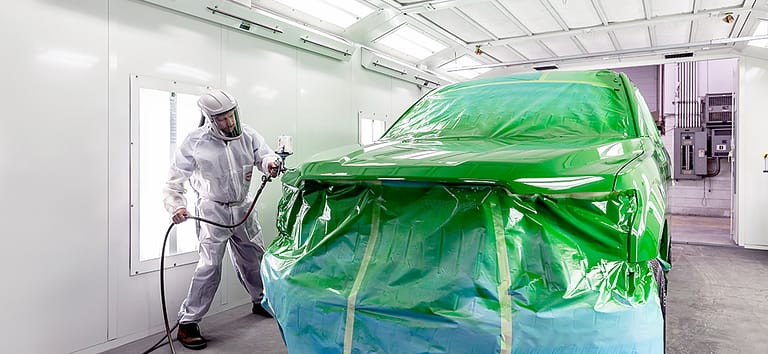
Whether using solvent-based or waterborne paint, it is nearly impossible to avoid volatile organic compounds (VOCs) — carbon-based compounds that when evaporated create flammable vapors.
The potentially hazardous effects of VOCs can be minimized by spraying in a high-quality paint booth that meets fire and life safety standards and wearing the appropriate level of personal protective equipment (PPE). This helps ensure the safety of your painters and the protection of your equipment.
Here are five important things to know about VOCs:
When released directly into the atmosphere, VOCs contribute to smog and ozone depletion. The VOCs exhausted by paint booths must meet the outdoor air quality requirements set by the EPA, as well as your state.
To obtain a permit to build a paint booth, you may need to disclose your emission level — denoted in anticipated tons per year of VOCs. If the VOC concentration is deemed too high by the Authority Having Jurisdiction (AHJ) for your area, you may have to look into other paint formulations or VOC abatement equipment.
“Ultimately, VOCs are going to be exhausted into the atmosphere, and there is the potential for it to be bad for everyone if proper precautions are not taken,” Global Finishing Solutions (GFS) senior mechanical engineer Geoff Raifsnider said.
Exposure to VOCs can cause eye, nose and throat irritation; shortness of breath; headaches; fatigue; nausea; dizziness; and skin problems. Higher concentrations of VOCs can cause irritation of the lungs, as well as damage to the liver, kidney and central nervous system.
When set up correctly, the paint booth and PPE work in conjunction to protect painters from VOCs. The type of PPE needed is determined by the level of exposure to VOCs.
Paint booths typically exhaust all of their air, with ventilation rates that often exceed the minimum requirements of the IFC and NFPA 33.
Recirculation booths are occasionally used in finishing industries to help lower heating and cooling costs by reducing the volume of air that is exhausted into the atmosphere. Since they bring potentially contaminated air back into the booth, they are required to be equipped with Lower Flammable Limit (LFL) monitors. GFS paint booths automatically shut down the spray application equipment at 25 percent of the LFL. However, the concentration of VOCs at this level may require a higher level of PPE.
The information needed to design the proper airflow can be found on the paint company’s safety data sheet (SDS) and their technical data sheet (TDS). Using this information, along with how much paint is being applied, GFS can design an airflow rate that keeps VOCs within code-compliant limits.
When custom designing airflow rates for paint booths, GFS asks customers what type of paints they plan to spray, both now and in the future. The airflow rates are designed to accommodate the VOC levels in those paints. Changes to their process — or the introduction of paints with higher VOC content — could require that the airflow rate be reconfigured.
A common question Raifsnider hears from customers: “I was spraying with that paint, now I’m going to spray with this paint. Do I have enough airflow?” The answer can be found in the airflow calculations, which are crucial for making sure VOCs are kept in check.
It is a myth that waterborne paint does not contain VOCs. Waterborne paint may be less toxic than solvent-based paint because there are fewer solvents, but there are some solvents in waterborne paint to attain the right consistency for application.
Automotive body shops and industrial manufacturers are increasingly switching from solvent-based to waterborne paint for premium finishes on vehicles and machinery. The trend toward waterborne paint is likely to continue as health and environmental issues are magnified. To help protect the environment, some cities and states have even banned the use of solvent-based paint that is not properly contained.
VOCs are a necessary evil of paint — you can’t have paint without solvents, which means VOCs will be released into the atmosphere when operating a paint booth. Shop owners should educate themselves about the risks associated with VOCs and make sure their shop is code-compliant, while painters should always wear PPE when spraying. This is the only way to protect your painters and your facility from the harmful effects of VOCs.
One of the best ways to highlight your business is through a story that you can share across your online platforms. It humanizes your business and shows that your business can make a meaningful impact. Your testimonial would be used as a project profile on the GFS Booth Blog and can be shared on your website and/or social media channels.
Complete this form and we’ll be in touch to showcase your company.

Shop a variety of GFS aftermarket products, including booth protection products and mobile accelerated curing units. And enjoy the convenience of fast and free ground shipping throughout the contiguous United States.

Located at GFS’ headquarters in Osseo, Wisconsin, the Center for Excellence is an innovative facility featuring an automotive refinish training center, as well as a separate space dedicated to technical product training.

GFS is continuously searching for talented, ambitious individuals to join our team. We aim to provide our employees with every opportunity to make an impact on the company and find their niche along the way — weather in a production, field services or an office position.